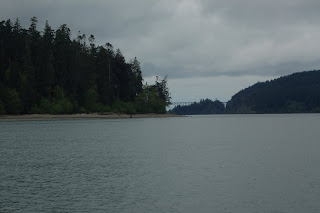After all the geeky photos of Sucia Island Marine State Park geology, Keith and I went back to the boat intent upon starting the engine to charge the house batteries while we had a nice hot shower. The hot shower part was no trouble. The solar shower had heated our five gallon bath water to 116 degrees.
But starting the engine? Mm. Is it supposed to make that noise? Didn't think so. This can't be good. Our house batteries were dead. Too dead to start the engine. Fortunately, there's a third battery held in reserve. We switched over to it, and the engine started right up. Okay. Back on track. At least our dead house batteries are being charged by the engine. We'll shower and get cleaned up. Everything will be fine. First, showering two people in five gallons of water in what amounts to a closet is no mean feat. You'll get no photos of that. Second, everything was not fine. The moment we shut down the engine, the house batteries began bleeding off their charge. Batteries aren't supposed to do this. It was clear we had at least one dead battery.
 Keith set to diagnosing the issue while I fired up the BBQ. That's when I saw this headed directly for us on the current. It's a tree. An entire, freaking huge tree. I know it looks like a black dot. But that black dot had a bead on us and circled in for the kill. Several times. When it became apparent it was going to hit us, I ran for the boat hook to fend it off. Keith apparently thought I was going to end up in the water, cause he dropped everything and came running when I began swearing at the tree just as it came close enough to poke with the boat hook. It hit us, but I'd slowed it way down and shunted it to one side, so the impact didn't even mar the gelcoat. I stood watch with the boat hook for a few hours until the outgoing tide sucked the monster out to sea. I wasn't sad to see it go...it would have been a long, cold night out there in the dark trying to figure out where it was.
Keith set to diagnosing the issue while I fired up the BBQ. That's when I saw this headed directly for us on the current. It's a tree. An entire, freaking huge tree. I know it looks like a black dot. But that black dot had a bead on us and circled in for the kill. Several times. When it became apparent it was going to hit us, I ran for the boat hook to fend it off. Keith apparently thought I was going to end up in the water, cause he dropped everything and came running when I began swearing at the tree just as it came close enough to poke with the boat hook. It hit us, but I'd slowed it way down and shunted it to one side, so the impact didn't even mar the gelcoat. I stood watch with the boat hook for a few hours until the outgoing tide sucked the monster out to sea. I wasn't sad to see it go...it would have been a long, cold night out there in the dark trying to figure out where it was.Keith found the dead battery, disconnected it, started the engine again to charge up the remaining house battery and said, "this'll get us through the night." Yeah. You see it coming, don't you? He uses a CPAP - a breathing machine. To run it off of the batteries, he has a tiny 400 Watt inverter that plugs into the 12 volt plug. At 4AM, the final house battery gave up the ghost. We discovered this the hard way because the inverter has a power interruption alarm that sounds like the hounds of hell are screaming in your ears. And I wear earplugs to bed. We levitated out of bed, pulled the inverter plug, calmed freaked out cats and humans, and watched the diesel heater choke and quit (it needs a tiny trickle of electricity to run - this battery had nothing to offer). We trudged back to bed and hoped the adrenaline would fade enough that we could get a few more hours' sleep.
Once the sun came up and we gave up pretending to snooze, we switched to the reserve battery, started the engine and diverted south to Friday Harbor on San Juan Island where we could blow yet more money replacing stuff. You do realize that when you're on a boat you walk everywhere? The West Marine in Friday Harbor is six blocks up from the marina or so. We had to carry two lead-acid batteries back to the boat. And then carry our spent batteries back to the store for core recycling. Suffice it to say it was a very long day. But the batteries are in and working beautifully. After a brief delay to accommodate a brush with the flu, we set out for Reid Harbor on Stuart Island. And look. We got to sail.
 We have the screecher up as we approach Spieden Island. The screecher is a large sail designed for use in light wind. Very versatile sail - it's on a track that allows us to shift the leading edge of the sail from one side of the boat to the other depending on wind angles. In this case, we had 11 to 13 knots of wind coming over our starboard aft quarter. Very comfortable and easy point of sail for a cat.
We have the screecher up as we approach Spieden Island. The screecher is a large sail designed for use in light wind. Very versatile sail - it's on a track that allows us to shift the leading edge of the sail from one side of the boat to the other depending on wind angles. In this case, we had 11 to 13 knots of wind coming over our starboard aft quarter. Very comfortable and easy point of sail for a cat. Yes. We could have put up more sail and gone faster, but it was such a nice day, we didn't see the point. Then we realized that the currents were taking us awfully close to the island with its danger marker (the tiny black and white thing in the photo left). Keith said, "Time to start the engine and furl the sail." I went top side to pull the furling line. The sail began rolling up on its furler. Then the line jammed. I may have said a bad word. The sail would not budge. I even tried getting a wrap on the winch to see if I couldn't pop the jam free. No go. And we were still getting closer to that stand off marker. I told Keith I'd deal with the sail, to go ahead and start the engine. He did and eased us around the tip of the island.
Yes. We could have put up more sail and gone faster, but it was such a nice day, we didn't see the point. Then we realized that the currents were taking us awfully close to the island with its danger marker (the tiny black and white thing in the photo left). Keith said, "Time to start the engine and furl the sail." I went top side to pull the furling line. The sail began rolling up on its furler. Then the line jammed. I may have said a bad word. The sail would not budge. I even tried getting a wrap on the winch to see if I couldn't pop the jam free. No go. And we were still getting closer to that stand off marker. I told Keith I'd deal with the sail, to go ahead and start the engine. He did and eased us around the tip of the island. When the furler on that sail jams, the only rememdy is to take the entire thing down and stuff it into the sail locker until you're someplace either at anchor or at dock. It's not a big huge thing to take the sail down in light wind like we had. In fact, once we rounded the tip of the island, we had no wind except what our motion generated. In 15 knots of wind, that great big sail is flat dangerous when it jams. No offense Shaeffer, but after putting in the rope guides and even switching to a smaller line size as suggested to prevent the countless jams just like this one, I think I can say this furler bites. If I had $2k I didn't know what to do with, I'd replace that itty-bitty piece of ... hardware with something reliable. Not that I'm bitter about hanging off the bow of my moving boat trying to release a pin so I could drop a sail that shouldn't have needed to be shoved in a messy lump into a locker. I'm also not bitter about spending precious hours of what should have been time relaxing at anchor having to manually unwrap and then rewrap furling line just so I could get the sail back up and working again. Yeah, that sunburn is totally the furling system's fault.
Eh-hem. So the sail is back up. It's furled now. But I doubt we'll entrust the safety of our boat and our family to that furler any more. It makes me sad. I really like that sail. Next: less whining, more photos. Stuart Island and Roche Harbor.









































